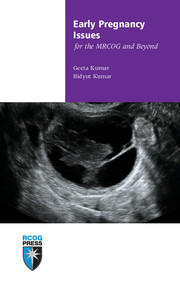Book contents
- Frontmatter
- Contents
- Dedication and acknowledgement
- About the authors
- Abbreviations
- Preface
- 1 Embryogenesis and physiology
- 2 Miscarriage
- 3 Recurrent miscarriage
- 4 Ectopic pregnancy
- 5 Trophoblastic disease
- 6 Hyperemesis gravidarum
- 7 Abdominal and pelvic pain in early pregnancy
- 8 Prescribing issues
- 9 Ultrasound and screening
- Further reading
- Index
- Published titles in the MRCOG and Beyond series
5 - Trophoblastic disease
Published online by Cambridge University Press: 05 July 2014
- Frontmatter
- Contents
- Dedication and acknowledgement
- About the authors
- Abbreviations
- Preface
- 1 Embryogenesis and physiology
- 2 Miscarriage
- 3 Recurrent miscarriage
- 4 Ectopic pregnancy
- 5 Trophoblastic disease
- 6 Hyperemesis gravidarum
- 7 Abdominal and pelvic pain in early pregnancy
- 8 Prescribing issues
- 9 Ultrasound and screening
- Further reading
- Index
- Published titles in the MRCOG and Beyond series
Summary
Gestational trophoblastic disease (GTD) defines a continuum of a neoplastic process that arises from the fetal chorion of the placenta (trophoblast). This group of disorders consists of diseases with a varying propensity for local invasion and metastasis. The World Health Organization (WHO) has classified GTD as two premalignant diseases consisting of complete or classical hydatidiform mole (CHM) and partial hydatidiform mole (PHM) and as three malignant disorders consisting of invasive mole, choriocarcinoma and placental site trophoblastic tumour (PSTT). The last three conditions are often collectively referred to as gestational trophoblastic neoplasia (GTN).
Epidemiology
Estimates for the incidence of various forms of GTD vary in different regions of the world. The incidence of molar pregnancy in Japan (2/1000 pregnancies) is three times greater than the reported incidence in Europe or North America (0.6–1.1/1000 pregnancies). In Taiwan, 1/125 pregnancies is molar, while in the USA the incidence is 1/1500 live births. In Ireland, the incidence of CHM and PHM has been determined to be 1/1945 and 1/695, respectively, by reviewing the pathology of all products of conception from first and second trimester terminations. GTN may develop after a molar pregnancy, a non-molar pregnancy or a live birth. Gestational choriocarcinoma occurs in approximately 1/20 000–40 000 pregnancies: approximately 50% after term pregnancies, 25% after molar pregnancies and the remainder after other gestational events. PSTT is much rarer than hydatidiform moles or gestational choriocarcinoma and can develop after any type of pregnancy.
- Type
- Chapter
- Information
- Early Pregnancy Issues for the MRCOG and Beyond , pp. 61 - 72Publisher: Cambridge University PressPrint publication year: 2011

